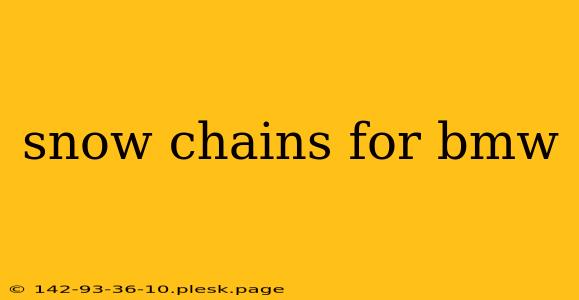Winter driving presents unique challenges, especially for high-performance vehicles like BMWs. Ensuring optimal safety and traction in snowy or icy conditions requires careful consideration of your vehicle and the right equipment. This comprehensive guide explores the intricacies of choosing and using snow chains for your BMW, helping you navigate winter roads with confidence.
Understanding Your BMW Model and Snow Chain Compatibility
Before purchasing snow chains, it's crucial to understand your BMW's specific requirements. Consult your owner's manual for detailed information regarding tire size, wheel specifications, and manufacturer recommendations. Ignoring these guidelines can lead to damage to your vehicle or compromised safety. Different BMW models have varying wheel sizes and clearances, impacting the type of snow chain that will fit.
Key Factors to Consider:
- Tire Size: This is the most critical factor. Snow chains are designed for specific tire dimensions (e.g., 225/45R18). Purchasing incorrect sizes will render the chains unusable.
- Wheel Type: Alloy wheels are more susceptible to damage from snow chains than steel wheels. Certain chain designs minimize this risk, but careful selection and installation are vital.
- Clearance: BMWs, especially those with larger wheels and low-profile tires, may have limited clearance between the tire and suspension components. You'll need chains designed for this reduced space to prevent rubbing or damage.
- Drive Type: While snow chains improve traction for all-wheel drive (AWD) and rear-wheel drive (RWD) BMWs, the installation process and considerations might slightly vary.
Types of Snow Chains Available for BMWs
Several types of snow chains cater to different needs and preferences. Understanding these differences is crucial for selecting the best option for your BMW:
1. Ladder-Style Snow Chains:
These are the most traditional and often the most affordable type. They feature interconnected metal links forming a ladder-like pattern. While effective, they can sometimes be noisy and may not be suitable for all BMW models due to clearance limitations.
2. Diamond-Pattern Snow Chains:
Offering improved traction and reduced noise compared to ladder-style chains, diamond-pattern chains are a popular choice. They feature a more intricate design for better grip on snow and ice. They often provide a better balance between performance and reduced wear on your tires.
3. Non-Metallic Snow Chains (Textile Chains):
These chains use textile materials instead of metal, reducing the risk of alloy wheel damage. They are generally quieter and offer good grip, but they might not be as durable as metal chains in extremely icy conditions. This is a good option for those prioritizing wheel protection.
Installing Snow Chains on Your BMW: A Step-by-Step Guide
Proper installation is critical for safety and effectiveness. Always refer to the specific instructions provided with your snow chains. Generally, the process involves:
- Park on a level surface: Ensure your vehicle is securely parked and the parking brake is engaged.
- Prepare the chains: Lay out the chains and familiarize yourself with the fastening mechanisms.
- Attach the chains: Carefully position the chains around your drive tires, following the manufacturer’s guidelines.
- Tighten securely: Ensure that the chains are tightly fastened to prevent slippage.
- Test Drive Carefully: Drive slowly at first, paying attention to the sound and feel of the chains.
Maintaining and Storing Your Snow Chains
Proper maintenance prolongs the life of your snow chains and ensures their effectiveness. After use, clean the chains thoroughly to remove snow, ice, and road salt. Store them in a dry place to prevent corrosion.
Choosing the Right Snow Chains for Your BMW: A Final Word
Selecting the appropriate snow chains for your BMW is vital for safe winter driving. Prioritize compatibility with your specific model, considering tire size, wheel type, and clearance. Investing in high-quality chains from reputable brands will provide peace of mind and superior performance during challenging winter conditions. Always remember to consult your owner's manual and follow the manufacturer's instructions for safe installation and usage.

